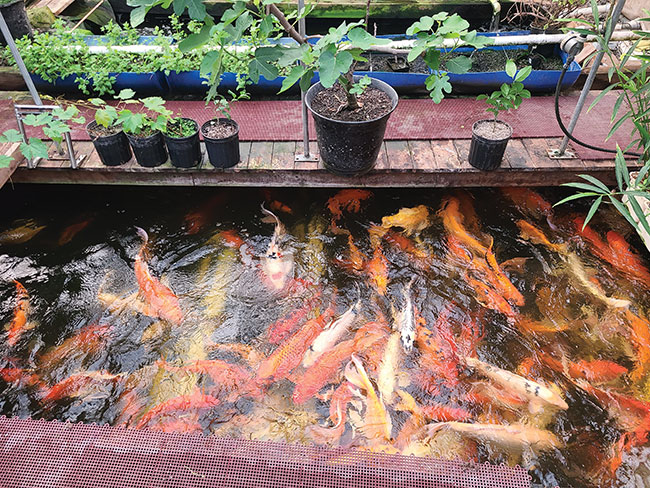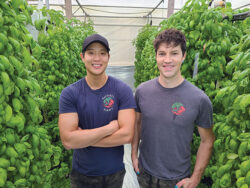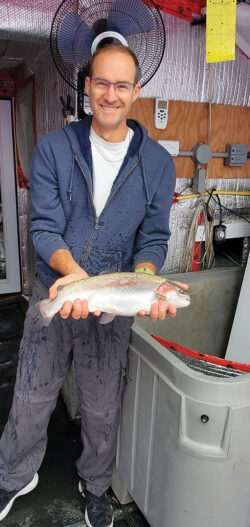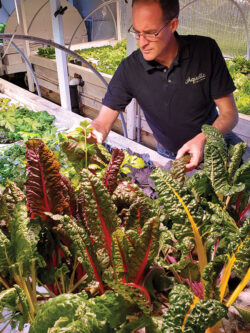
Features
Crops
Aquaponics update
A look at various facilities across Canada producing hort crops and fish
December 1, 2023 By Treena Hein
 Rafferty Farms, located near Okotoks, Alta., is home to nearly 175 koi. This aquaponic operation specializes in Genovese Basil, mint pea shoot and microgreens. The koi are not sold and even have names.
Photo: Earthis Ltd.
Rafferty Farms, located near Okotoks, Alta., is home to nearly 175 koi. This aquaponic operation specializes in Genovese Basil, mint pea shoot and microgreens. The koi are not sold and even have names.
Photo: Earthis Ltd. Worldwide, both the aquaculture and greenhouse industries are growing because they are stable sources of safe, high-quality food. Combining them in aquaponics makes huge sustainability and efficiency sense, where nutrients from fish waste in the tank water is used to fertigate plants. Fish also offer the most efficient feed conversion of any farmed animal — as little as 1.5 pounds of feed/pound gained.
Here’s a look at some of the current aquaponics operations in Canada. From a profit perspective, revenues come first from crops due to their much shorter harvest timelines, and plant profits can be higher than fish, but not always.
At Aquanure/Croxall Farms in Huntsville, Ont., for example, they have consistently experienced growth opportunities in both crop and fish. For seven years, owner Todd Croxall and his team have grown a variety of greens, herbs, strawberries and peppers in a pillared system, with ongoing parallel production of Japanese koi. Crops and premium koi go into local retail and restaurant markets, with some of these fish shipped directly to customers. Standard koi are sold to Koi resellers such as nurseries and aquarium franchises.
From the perspective of Julien Le Net, co-founder of ÉAU in Montreal, Que., the volume of fish production plays a role in profitability. “Aquaponic fish can also be certified organic, which brings an added value,” he explains. Other forms of added value are being pursued by ÉAU as well. “For example in one of our farms,” says Le Net, “we have put in place the equipment to produce cold-smoked Arctic char. This will be a pretty unique product in the current market.”
ÉAU is currently developing a dozen community/educational or commercial projects for clients, mainly in Quebec, but also internationally. Combined, these farms will produce more than 100 tonnes of fish and 1000 tonnes of crop harvest each year. The most advanced project in Montreal will begin operations in 2024. ÉAU also has its own tech showcase and R&D facility that’s been operating for more than two years.
Projects are pursued based on market, technical and regulatory studies completed for their clients, with vertical indoor or greenhouse production of greens, herbs, microgreens, and standard crops (tomato, cucumber, pepper, strawberry). For commercial clients, it’s typically Rainbow Trout or Arctic char, but Le Net says “we are also developing yellow perch and walleye.”
Scott Allin, owner of Aquatic Growers in Muskoka, Ont., has grown a variety of crops and fish species since 2013. He now grows Rainbow trout and mainly salad greens.
Added revenue from fingerling sales
In High River, Alta., Alberta Tilapia Aquaponics grows about 10000 lbs of cherry tomatoes and about 5000 lbs of fish per year, sold mostly through the Sobey’s chain and also local grocery stores. This firm is also the biggest Canadian supplier of tilapia fingerlings (white, blue and hybrid), about 25,000 annually. Owner Gerrit Swanpoel also supplies fish to universities like Dalhousie for research. The operation is continuing to expand and Swanpoel plans to bring in another fish species soon. “The market is still looking for more fresh fish grown in a controlled environment,” he says.
Focus on basil

Rafferty Farms
co-owners Brian Hsu and James Rafferty.
However, Rafferty Farms (Earthis Ltd.) near Okotoks, Alta. only does crop sales. Co-owners Brian Hsu and James Rafferty grow 90 per cent Genovese basil (200 lbs per week) with the rest mint pea shoots and microgreens. They sell primarily to large chain grocery stores, but also restaurants and boutique retailers.
It took from the start of 2015 to about 2021 to become profitable, but during the past two years, sales have grown to the point of maxing out capacity. A tripling of current crop capacity will begin soon. “Our goal is to supply basil to all of Alberta,” says Rafferty, “and then Western Canada.”
There are about 175 koi, which are like pets, and many have names. “We’re glad we didn’t go down the route of fish sales since that business requires diverse skills and different regulations and rules than selling greens,” Rafferty shares. “We also know of other aquaponics companies that discontinued fish sales due to lack of profitability from that revenue stream.”
High-protein specialty crop
Building on past experiences, Stack Industries is now building a facility on the outskirts of Vancouver with Rainbow trout and water lentil production in three 10-acre greenhouses. “We’re also setting aside a fraction of production to do R&D in the nutraceutical and biofuel industries, but the lion’s share of production is for food,” explains Steve McArthur, founding partner and chief technology officer. Water lentils, also called duckweed, are tiny fast-growing plants that contain 42 per cent protein, Omega fatty acids, antioxidants, calcium, iron, carbohydrates and many micronutrients. Stack Industries plans to have facilities across the country and eventually in other countries.
Fertigation management
Some aquaponics systems integrate plants and fish completely, with plants growing in floating beds in the fish tanks. However, many times the two production systems are ‘decoupled’ (also called the ‘hydroponic approach), where water is not returned to the fish. The effluent can be carefully managed and treated, and the plant nutrients are supplemented as needed. While nutrient management is a huge topic, here is an overview of how it’s handled at these operations.

Scott Allin, owner of Aquatic Growers in Muskoka, Ont., has raised a number of different fish in his operation since its inception in 2013 but now he primarily grows rainbow trout.
At Croxall farms, a decoupled system is used and some of the fish waste is sold as ‘Aquanure’ fertilizer. “We manage plant inputs through careful monitoring,” says Croxall.
“Nutrient levels from fish waste may fluctuate, but we’ve honed our RAS (recirculating aquaculture system) to maintain consistency. Iron is added but aquatic maturity and proper bio-reaction with consistent dissolved oxygen levels help mitigate most problems when fine tuning the acidic relationship between aquatic life and plants. We’ve noticed that a properly-managed RAS can operate flawlessly when we meticulously control key variables and comprehend how these variables (e.g. nitrate conversion ratios) intricately interact. The system’s harmony lies in the ability to manipulate and fine tune critical aspects such as the water quality as a whole, human interaction variables, feed and micro mineral levels, pH, temperature, and fish density, along with many more. Each element is interdependent, impacting the entire ecosystem.”
Alberta Tilapia Aquaponics also has a decoupled system. The plants receive a steady amount of nitrates (achieved on system maturation) and Swanpoel adds other nutrients as needed.
At ÉAU’s developing community projects, some coupled systems are planned, but at the commercial farms in development, it’s decoupled systems with a mineralization system for effluent. “Once the mineralization system has reached maturity after three to six months, almost all the organic matter from the fish is converted into inorganic matter that can be assimilated by the plants,” Le Net explains. “Then, depending on the size of the plant production sections, very little additional fertilizer, mainly iron, may be required. If the project is deliberately unbalanced for technical reasons, and fish production is not sufficient to meet plant needs, then organic or synthetic fertilizers must be added, using peristaltic pumping to calibrate the nutrient solution.”
Rafferty Farms (which only sells crops) has a single circulating water system which is fully integrated. “Waste from the fish is never removed as it fully decomposes in our growing towers via worms and other organisms,” Rafferty explains. “We designed our tower system to act as a waste filter before the water returns to the fish tank. We designed the system with over 60,000L of circulating water to ensure the balance of nutrients in the system stays as consistent as possible. We found at the beginning in the first few months the pH would drift, but after about the first year the water chemistry is very stable. We do lab water testing every two weeks, and we supplement where needed to ensure we have the perfect balance of micronutrients in the water. We do not add any synthetic fertilizers.”
At the Aquaculture Centre of Excellence at Lethbridge College in Alta., Centre Chair Dr. John Derksen and Dr. Nick Savidov pursue an ‘ecosystem approach’ where the RAS promotes the natural development of beneficial organisms. Fish waste nutrient use by crops is maximized, as is the biofiltration ability of plants to remove phosphorous and nitrogen from fish waste. The Centre has nine small aquaponics systems which have been continuously recirculated for almost 20 years using innovative carbon-based filter beds, bioreactors and more.
Allin at Aquatic Growers uses a coupled deep water culture hydroponic system. “Overall, I have learnt to listen to the plants and monitor and test when needed,” he says. “Some tests are daily while others are weekly to monthly…I find too many people are focused on attaining a particular level of each nutrient instead of focusing on what the plants are showing you and working within a safe range of nutrient parameters.”
Future outlook
Many aquaponic operations in Canada and around the world have started up and failed due to a variety of factors; from a hurricane wiping out an operation in Newfoundland in recent years, to the pandemic to more typical reasons such as market changes and poor business acumen.

Scott Allin inspects a crop of salad greens at his aquaponic operation, Aquatic Growers, in Muskoka, Ont.
Obviously, all the aquaponics leaders in this story see a bright future for the sector, and more experience and knowledge-sharing will pave the way for expansion. Research continues at the Aquaculture Centre of Excellence into a variety of technological areas.
Allin notes that there’s a great deal of misinformation about aquaponics, especially on social media, and information on best practices is sorely needed. “There is money to be made in this industry, providing you over-project your problems and under-project your profits in the beginning,” he says. “My best advice to anyone wishing to start in this industry, no matter where they live in the world, is to start small and expand as their knowledge grows.”
Allin would also like public knowledge about food production to grow. This is a priority at Scadding Court Community Centre in Toronto, which has had an aquaponics lab since 2016. They produce 400 lbs of Blue Nile tilapia a year and about 12 lbs of greens per week.
“The project has provided the community centre with a vehicle to engage and educate community members of all ages on topics including the food chain, ecosystems and sustainable urban agriculture,” says lab manager Jake Rutland. “Scadding Court has also used it as a platform to employ youth, helping them develop entrepreneurial skills by building relationships with local restaurants and selling specialty produce requested by the chefs themselves. Most recently, due to rising food costs, the centre has used the lettuce grown in-house to offset food costs for kids, adult, and senior programming meals.”
Print this page